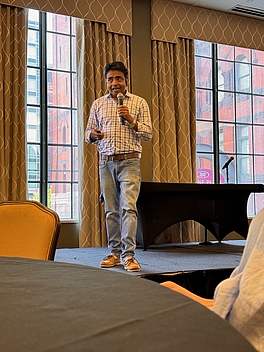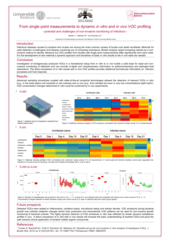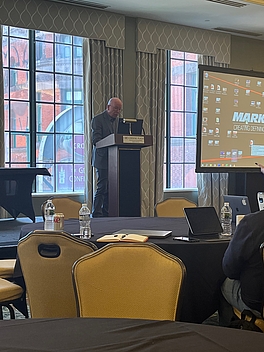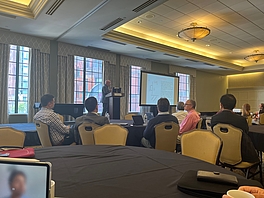IABR Summit Indianapolis 03. - 06.06.2024
Programm und weitere Informationen
Breakthrough Developments and Discoveries
|
Abstract Content
Background
Isoprene (1,3-pentadiene, C5H8) is amongst the most abundant volatile metabolites produced by plants and animals. In humans, endogenously produced isoprene is exhaled in nearly everybody’s breath in high amounts and has been described as a potential biomarker for various diseases1. Exhaled isoprene is extremely dynamic in nature2 and concentration changes are also related to physio-metabolic, inherited conditions and ageing3–5. Based on pre-clinical in vitro experiments, Deneris et al hypothesized that cholesterol biosynthesis in the liver potentially gives rise to isoprene in our breath6. Nevertheless, changes and/or differences observed in breath isoprene under various conditions investigated in clinical studies could not be justified by the suggested origin. Thus, missing knowledge of the origin and pathways involved hindered the translation of this biomarker into clinical practice. Isoprene absent healthy adults is rare (<0.3/%) in the nature. Our previous investigations in such a healthy German adult and her family (isoprene deficient) disqualified the putative origin and depicted a recessive inheritance of this phenotype7.
Objective
We aimed to find the human metabolic origin of isoprene8.
Methods
In consecutive clinical breath screening studies, amongst 2000 subjects, we identified five healthy German adults without breath isoprene. After having the ethical clearance, we conducted venous blood collection, peripheral blood mononuclear cells isolation, DNA isolation, multi-omics (breathomics, genomics) and serological metabolites analysis in healthy isoprene aberrated and isoprene normal adults8.
Results
We obtained five (3 females and 2 males) isoprene absent healthy adults, 64 (39 females and 25 males) isoprene deficient (with low exhaled concentrations <50ppbV). Whole exome sequencing in these individuals revealed only one shared homozygous (<1% prevalent in Europeans) IDI2 stopgain mutation (at c.431 position) causing loss of enzyme active site and Mg–cofactor binding sites and thereby, preventing conversion of isopentenyl diphosphate to dimethylallyl diphosphate (DMAPP) in cholesterol metabolism. Targeted sequencing depicted that the IDI2 variant is heterozygous in isoprene deficient blood-relatives and absent in unrelated isoprene normal adults. Wildtype IDI1 and cholesterol metabolism related serological parameters were normal in everyone. Unlike other mammals, naturally IDI2 knocked out pigs and bottlenose dolphins exhale no isoprene. Human IDI1 is expressed highly in liver but the hepatocellular cytochrome P450 enzymes immediately oxidizes isoprene. Skeletal muscles metabolize lipids (oxidize cholesterol, fatty acids) to produce energy, regulate intramyocellular signalling and integrity. Peroxisomal beta-oxidation produces acetyl-CoA i.e., channelled towards DMAPP production. Thus, human IDI2 determines isoprene production as DMAPP is the only source of isoprene and unlike plants, humans lack isoprene synthase and its enzyme homologue. Human IDI2 is only expressed in skeletal-myocyte peroxisomes and instant spikes in isoprene exhalation during any muscle activity underpin the origin from muscular lipolytic cholesterol metabolism.
Conclusions
Our discovery of the genetic origin and metabolic routes of human isoprene production enabled objective interpretations and applications of isoprene as a noninvasive biomarker. Knowledge of accurate metabolic source and normal/dynamic range are indispensable for valid clinical interpretation of any endogenous marker. Besides isoprene, our breath contains many potentially endogenous VOCs and their origins are yet uncertain.


Poster Presentation & Flash Talk
A
|
Abstract Content
Background
Malnutrition and sarcopenia are common concomitant symptoms of liver cirrhosis and are both independent predictors of morbidity and mortality, yet they are frequently missed due to their challenging detection. TIPS is a therapeutic intervention aimed at preventing further severe complications in these patients. This intervention often leads to an improvement in the nutritional and muscular status.
Objective/aims
The aim of the study is an exploratory analysis of the relationship between exhaled VOC profiles and (patho-)physiological changes in cirrhotic patients with TIPS.
Methods
Following ethical approval, breath gas samples were collected from 5 cirrhotic patients before and 6 months after TIPS placement. MR imaging was performed to correlate VOCs with muscle status. CO2 controlled breath sampling was done during the alveolar phase of expiration into inert, pre-conditioned glass syringes. In all patient’s heart rate, blood pressure and cardiac output were recorded by means of non-invasive hemodynamic monitoring (Clearsight, Edwards Lifesciences, California, USA). Breath gas was analyzed by means of proton transfer reaction-mass spectrometry. A part of the breath samples was pre-concentrated using solid-phase micro-extraction and analyzed using gas chromatography-mass spectrometry for identification of unknown compounds.
Results
We observed changes in exhaled VOC profiles between samples taken before and after implantation of TIPS. Endogenous saturated and unsaturated aldehydes, ketones, organo-sulphur compounds, short-chain fatty acids, alcohols and exogenous nitriles, terpenes and aromatic substances reflected cirrhosis driven physio-metabolic changes. Some changes in VOC concentrations correlate with simultaneously occurring changes in hemodynamics and ventilation, other markers are related to changes of the muscular status.
Conclusion
As a quick and entirely non-invasive approach, VOC profiling has the potential to provide extensive and novel insights into sarcopenia and malnutrition in patients with liver cirrhosis. Additionally, VOC profiles recorded after TIPS implantation can provide valuable information on effects of portal venous blood shunting. This knowledge is of special interest in relation to liver metabolic activity in cirrhosis and for understanding TIPS induced cerebral dysfunction.




Poster Presentation
|
Abstract Content
Background
Infectious diseases caused by bacteria and viruses are one of the most common causes of burden and death worldwide. Methods for a rapid detection of infectious pathogens and monitoring of the resulting disease are of increasing importance. In the last decades, breath analysis raised increasing interest as a non-invasive method to characterize and monitor VOC profiles during infections. For the development of new methods and basic understanding of pathogen–VOC relations a translation of basic in vitro results to the in vivo state is needed.
Methods
In vitro studies were performed by infecting human pharynx cells with defined bacterial strains and/or viruses. VOC profiles were monitored in a hermetically closed sampling system over a defined time period. In vivo studies were conducted in an infected large animal (pig) model. Alveolar samples were withdrawn under capnometric control. VOCs were pre-concentrated from 20 ml aliquots onto copolymer needle trap devices. Pre-concentrated VOCs were thermally desorbed, separated by gas chromatography and identified/quantified by means of mass spectrometry.
Results
Advanced sampling procedures coupled with modern analytical technologies allowed the detection of VOCs in vitro (e.g., in the gas space over bacterial or cell cultures) and in vivo (e.g., from exhaled air) even in very low concentrations (ppbV-pptV). Some post infection VOC concentration changes in vitrocould be confirmed by in vivo experiments. Other marker compounds identified in in vitro setup were not found in the exhaled breath of animals. Relevant VOCs were related to inflammation, oxidative stress, microbiome status and cellular demise. The highly dynamic behavior of VOC emissions in vitro was reflected by similar dynamic exhalations profiles in vivo.
Figure 1: Boxplots of Acetaldehyde and Propanal in vitro and in vivo. 1. Compound target response of S. suis infected (green) and uninfected cell culture over a time course of 72 h. 2. Concentration changes detected in breath samples of pigs over a time course of 21 days in infected (red) and control group (green). 3. Compound target response of S. suis infected (green) and uninfected cell culture over a time course of 72 h. 4. Concentration changes detected in breath samples of pigs over a time course of 21 days in infected (red) and control group (green). The selected substances show an increase after bacterial S. suis infection both in vitro and in vivo.
Conclusions
The investigation of endogenously produced volatile organic compounds in a translational setup from in vitro to in vivo offers great potential for rapid and non-invasive monitoring of infections and can provide in-depth and complementary information about the pathomechanisms and pathogen-host interactions. The direct comparison from in vitro results with in vivo VOC profiles provides additional biomolecular information on the infection process and the host response.



Morning Session
Author Name: | Jochen Schubert- Rostock University Medical Center |
Session Title: | Closing Session |
Event Title: | What breath research can learn from the Corona pandemics |
Co-Authors | Pritam Sukul, Felix Klawitter, Wolfram Miekisch |
Date: | Thursday, June 06, 2024 |
Start Time: | 10:10 AM |
Location: | Crowne Plaza, Indianapolis |
Abstract Content
Background
For more than two years the corona pandemic has challenged medicine, medical sciences and societies worldwide in an unprecedent way. Within the scientific world, we encountered serious problems concerning generation of reliable data in short times, scientific honesty and correctness and the difficult interaction between research and politics. As fast and reliable recognition of infection played a pivotal role in limiting the spread of the virus, diagnostic methods other than PCR or antigene testing were sought and non-invasive breath analysis seemed to be attractive and promising in this context.
Objective/Aims: This talk will analyse conclusions and assumptions drawn from breath related studies published during the pandemic.
Methods
Applied analytical methods, study setup and statistical procedures will be assessed in detail. Special attention will be paid to study populations, patient recruitment, inclusion and exclusion criteria and statistical methods used for data processing.
Results
Several studies proposing volatile marker sets for diagnosis of corona infections/CoVid were identified. With only one exception all proposed markers were different from each other. Study populations were very heterogenous, patients with mild and severe disease states were analyzed together. All but one study were not prospective as they compared patients with known infection to healthy controls. The majority of studies used low patient numbers, and complex statistical methods were preferably applied. FDA approval was obtained for a test based on unknown/not disclosed volatiles.
Conclusion
The lessons we have to learn from these results are serious. Even in a pandemic with urgent need of data and new knowledge scientific vigour has to be conserved as impact of conclusions and directions not based on reliable data can be disastrous for science and its credibility. Well-known pitfalls concerning low patient numbers, predefined study groups with unrealistic disease prevalence and statistical overfitting have to be avoided. In addition, any new test has to be compared realistically to existing methods in terms of reproducibility, sensitivity and specificity.


